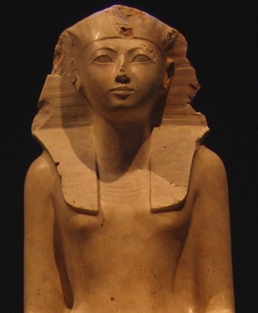
She was the daughter of King Thutmose I, Hatshepsut ultimately became Queen of Egypt when she married her half-brother, Thutmose II, at 12 years of age. Upon his death, she began acting as regent for her stepson, the infant Thutmose III, but later took on the full powers of a pharaoh, becoming co-ruler of Egypt around 1473 B.C.
Hatshepsut was only the third woman to become pharaoh in 3,000 years of ancient Egyptian history, and the first one with full power of the position. Cleopatra, who also exercised such power, would rule some 14 centuries later.
She was depicted at her request as a male in many contemporary images and sculptures, Hatshepsut remained largely unknown to scholars until the 19th century.
As pharaoh, Hatshepsut extended Egyptian trade and oversaw ambitious building projects, most notably the Temple of Deir el-Bahri, located in western Thebes, where she would be buried. Hatshepsut probably died around 1458 B.C., at her mid-40s. She was buried in the Valley of the Kings, located in the hills behind Deir el-Bahri. In another effort to legitimize her reign, she had her father’s sarcophagus reburied in her tomb so they could lie together forever.
Hatshepsut: http://www.biography.com/people/hatshepsut-9331094
The Queen Who Would Be King http://po.st/miQuew via @SmithsonianMag
Hatshepsut: http://ngm.nationalgeographic.com/2009/04/hatshepsut/brown-text
Codex Gigas Devil’s Bible - the largest manuscript in the world http://shar.es/1g9y3O
History.com
Getting Started: https://youtu.be/0uY7gLZDmn4 via @YouTube